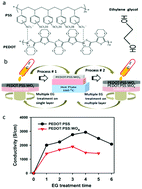Improved power conversion efficiency of perovskite solar cells using highly conductive WOx doped PEDOT:PSS†
Abstract
Poly(3,4-thylenedioxythiophene):poly(styrene sulfonate), PEDOT:PSS, is a popular and cost effective conducting polymer for electrodes that can also be used as a hole transport layer (HTL) in optoelectronics. In this article, we investigated the role of ethylene glycole (EG) in the conductivity enhancement of PEDOT:PSS and WOx doped PEDOT:PSS films. Multiple EG solvent treatments increase the conductivity up to 3000 S cm−1 (PEDOT:PSS) and 1980 S cm−1 (PEDOT:PSS:WOx). EG treated PEDOT:PSS:WOx thin films exhibited transmittance as high as 95% in the visible range and sheet resistance as low as 35 Ω sq−1. And, PEDOT:PSS films exhibited sheet resistance of 25 Ω sq−1 at 90% transmittance, which is the lowest value reported to date to the best of our knowledge. Additionally, thin films treated with EG multiple times exhibit improved thermal stability; thin films annealed at 250 °C have shown a remarkable stable conductivity. Furthermore, these layers are investigated as HTLs for high efficiency perovskite solar cells (PSCs). Neat PEDOT:PSS and PEDOT:PSS:WOx, and EG treated PEDOT:PSS and PEDOT:PSS:WOx integrated in PSCs demonstrated a power conversion efficiency (PCE) of 9.17%, 10.42%, 12.31% and 12.69%, respectively. The improved performance of cells with modified PEDOT:PSS HTLs results in improved current density and fill factor.



 Please wait while we load your content...
Please wait while we load your content...